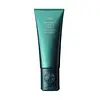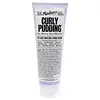What's inside
What's inside
 Key Ingredients
Key Ingredients

No key ingredients
 Benefits
Benefits

 Concerns
Concerns

 Ingredients Side-by-side
Ingredients Side-by-side

Water
Skin ConditioningGlycerin
HumectantCetearyl Alcohol
EmollientIsoamyl Laurate
EmollientCetyl Esters
EmollientIsopropyl Palmitate
EmollientBehentrimonium Methosulfate
Parfum
MaskingPolyquaternium-72
Butylene Glycol
HumectantCetrimonium Chloride
AntimicrobialButyrospermum Parkii Butter
Skin ConditioningHydroxyethylcellulose
Emulsion StabilisingSodium PCA
HumectantXanthan Gum
EmulsifyingWheat Amino Acids
Skin ConditioningAstrocaryum Murumuru Seed Butter
EmollientMangifera Indica Seed Butter
Skin ConditioningTheobroma Cacao Seed Butter
EmollientTheobroma Grandiflorum Seed Butter
Skin ConditioningCocos Nucifera Fruit Extract
EmollientCitrullus Lanatus Fruit Extract
Skin ConditioningLitchi Chinensis Fruit Extract
Skin ConditioningDisodium Phosphate
BufferingPolysorbate 60
EmulsifyingOlea Europaea Fruit Oil
MaskingPersea Gratissima Oil
Skin ConditioningSimmondsia Chinensis Seed Oil
EmollientLeontopodium Alpinum Flower/Leaf Extract
Skin ConditioningTocopherol
AntioxidantPhenoxyethanol
PreservativeEthylhexylglycerin
Skin ConditioningSodium Phosphate
BufferingPotassium Sorbate
PreservativeCitric Acid
BufferingSodium Benzoate
MaskingLimonene
PerfumingHexyl Cinnamal
PerfumingLinalool
PerfumingCitral
PerfumingWater, Glycerin, Cetearyl Alcohol, Isoamyl Laurate, Cetyl Esters, Isopropyl Palmitate, Behentrimonium Methosulfate, Parfum, Polyquaternium-72, Butylene Glycol, Cetrimonium Chloride, Butyrospermum Parkii Butter, Hydroxyethylcellulose, Sodium PCA, Xanthan Gum, Wheat Amino Acids, Astrocaryum Murumuru Seed Butter, Mangifera Indica Seed Butter, Theobroma Cacao Seed Butter, Theobroma Grandiflorum Seed Butter, Cocos Nucifera Fruit Extract, Citrullus Lanatus Fruit Extract, Litchi Chinensis Fruit Extract, Disodium Phosphate, Polysorbate 60, Olea Europaea Fruit Oil, Persea Gratissima Oil, Simmondsia Chinensis Seed Oil, Leontopodium Alpinum Flower/Leaf Extract, Tocopherol, Phenoxyethanol, Ethylhexylglycerin, Sodium Phosphate, Potassium Sorbate, Citric Acid, Sodium Benzoate, Limonene, Hexyl Cinnamal, Linalool, Citral
Water
Skin ConditioningParaffinum Liquidum
EmollientPEG-12
HumectantDimethicone
EmollientGlycerin
HumectantAcrylic Acid/Vp Crosspolymer
Parfum
MaskingPhenoxyethanol
PreservativeCaprylyl Glycol
EmollientEthylhexylglycerin
Skin ConditioningAloe Barbadensis Leaf Juice
Skin ConditioningGlycine Soja Oil
EmollientEthylhexyl Methoxycinnamate
UV AbsorberOleth-5
EmulsifyingAminomethyl Propanol
BufferingPersea Gratissima Oil
Skin ConditioningButyrospermum Parkii Butter
Skin ConditioningPrunus Amygdalus Dulcis Oil
Skin ConditioningSimmondsia Chinensis Seed Oil
EmollientMacadamia Integrifolia Seed Oil
Skin ConditioningSilk Amino Acids
HumectantDisodium EDTA
CI 60725
Cosmetic ColorantWater, Paraffinum Liquidum, PEG-12, Dimethicone, Glycerin, Acrylic Acid/Vp Crosspolymer, Parfum, Phenoxyethanol, Caprylyl Glycol, Ethylhexylglycerin, Aloe Barbadensis Leaf Juice, Glycine Soja Oil, Ethylhexyl Methoxycinnamate, Oleth-5, Aminomethyl Propanol, Persea Gratissima Oil, Butyrospermum Parkii Butter, Prunus Amygdalus Dulcis Oil, Simmondsia Chinensis Seed Oil, Macadamia Integrifolia Seed Oil, Silk Amino Acids, Disodium EDTA, CI 60725
Ingredients Explained
These ingredients are found in both products.
Ingredients higher up in an ingredient list are typically present in a larger amount.
This ingredient is also known as shea butter. It is an effective skin hydrator and emollient.
Emollients help soothe and soften your skin. It does this by creating a protective film on your skin. This barrier helps trap moisture and keeps your skin hydrated. Emollients may be effective at treating dry or itchy skin.
Shea butter is rich in antioxidants. Antioxidants help fight free-radicals, or molecules that may harm the body. It is also full of fatty acids including stearic acid and linoleic acid. These acids help replenish the skin and keep skin moisturized.
While Shea Butter has an SPF rating of about 3-4, it is not a sunscreen replacement.
Shea butter may not be fungal acne safe. We recommend speaking with a professional if you have any concerns.
Learn more about Butyrospermum Parkii ButterEthylhexylglycerin (we can't pronounce this either) is commonly used as a preservative and skin softener. It is derived from glyceryl.
You might see Ethylhexylglycerin often paired with other preservatives such as phenoxyethanol. Ethylhexylglycerin has been found to increase the effectiveness of these other preservatives.
Glycerin is already naturally found in your skin. It helps moisturize and protect your skin.
A study from 2016 found glycerin to be more effective as a humectant than AHAs and hyaluronic acid.
As a humectant, it helps the skin stay hydrated by pulling moisture to your skin. The low molecular weight of glycerin allows it to pull moisture into the deeper layers of your skin.
Hydrated skin improves your skin barrier; Your skin barrier helps protect against irritants and bacteria.
Glycerin has also been found to have antimicrobial and antiviral properties. Due to these properties, glycerin is often used in wound and burn treatments.
In cosmetics, glycerin is usually derived from plants such as soybean or palm. However, it can also be sourced from animals, such as tallow or animal fat.
This ingredient is organic, colorless, odorless, and non-toxic.
Glycerin is the name for this ingredient in American English. British English uses Glycerol/Glycerine.
Learn more about GlycerinParfum is a catch-all term for an ingredient or more that is used to give a scent to products.
Also called "fragrance", this ingredient can be a blend of hundreds of chemicals or plant oils. This means every product with "fragrance" or "parfum" in the ingredients list is a different mixture.
For instance, Habanolide is a proprietary trade name for a specific aroma chemical. When used as a fragrance ingredient in cosmetics, most aroma chemicals fall under the broad labeling category of “FRAGRANCE” or “PARFUM” according to EU and US regulations.
The term 'parfum' or 'fragrance' is not regulated in many countries. In many cases, it is up to the brand to define this term.
For instance, many brands choose to label themselves as "fragrance-free" because they are not using synthetic fragrances. However, their products may still contain ingredients such as essential oils that are considered a fragrance by INCI standards.
One example is Calendula flower extract. Calendula is an essential oil that still imparts a scent or 'fragrance'.
Depending on the blend, the ingredients in the mixture can cause allergies and sensitivities on the skin. Some ingredients that are known EU allergens include linalool and citronellol.
Parfum can also be used to mask or cover an unpleasant scent.
The bottom line is: not all fragrances/parfum/ingredients are created equally. If you are worried about fragrances, we recommend taking a closer look at an ingredient. And of course, we always recommend speaking with a professional.
Learn more about ParfumPersea Gratissima Oil is also known as avocado oil.
Avocado Oil has antioxidant properties. It is mostly made up of the glycerides of fatty acids. About 67% of these fatty acids is made up of oleic acid. Palmitic acid and linoleic acid are also present.
These fatty acids help hydrate and soften the skin. It may increase collagen content in the skin. Collagen helps keep your skin plump and firm. This ingredient helps reduce inflammation and has not shown to clog pores.
This ingredient may not be fungal-acne safe due to its high fatty acid content.
Avocados also have B vitamins, vitamin K, vitamin C, vitamin E, and potassium.
Learn more about Persea Gratissima OilPhenoxyethanol is a preservative that has germicide, antimicrobial, and aromatic properties. Studies show that phenoxyethanol can prevent microbial growth. By itself, it has a scent that is similar to that of a rose.
It's often used in formulations along with Caprylyl Glycol to preserve the shelf life of products.
This oil comes from the seeds of the desert shrub called Jojoba. It is more commonly known as jojoba oil, a non-comedogenic oil.
Jojoba oil does not contain fragrance and has many fatty-acids, making it a great soothing ingredient.
It also contains Vitamin E, a great moisturizing ingredient. Vitamin E is also an antioxidant and protects your skin against oxidative damage.
This ingredient humectant properties, meaning it helps draw moisture from the air. This helps keep your skin hydrated.
While jojoba has antibacterial properties, it is only able to kill some strains of bacteria.
Studies also show it helps in wound healing. In fact, Indigenous cultures have used jojoba as a moisturizer and to help treat burns for centuries.
Fun fact: Jojoba oil similar to natural human skin sebum, so it has a great effect on dry skin. It is also promising with helping to regulate sebum production.
Due to its fatty acid content, Jojoba oil may not be fungal acne safe. We recommend speaking with a professional if you have any concerns.
Learn more about Simmondsia Chinensis Seed OilWater. It's the most common cosmetic ingredient of all. You'll usually see it at the top of ingredient lists, meaning that it makes up the largest part of the product.
So why is it so popular? Water most often acts as a solvent - this means that it helps dissolve other ingredients into the formulation.
You'll also recognize water as that liquid we all need to stay alive. If you see this, drink a glass of water. Stay hydrated!
Learn more about Water